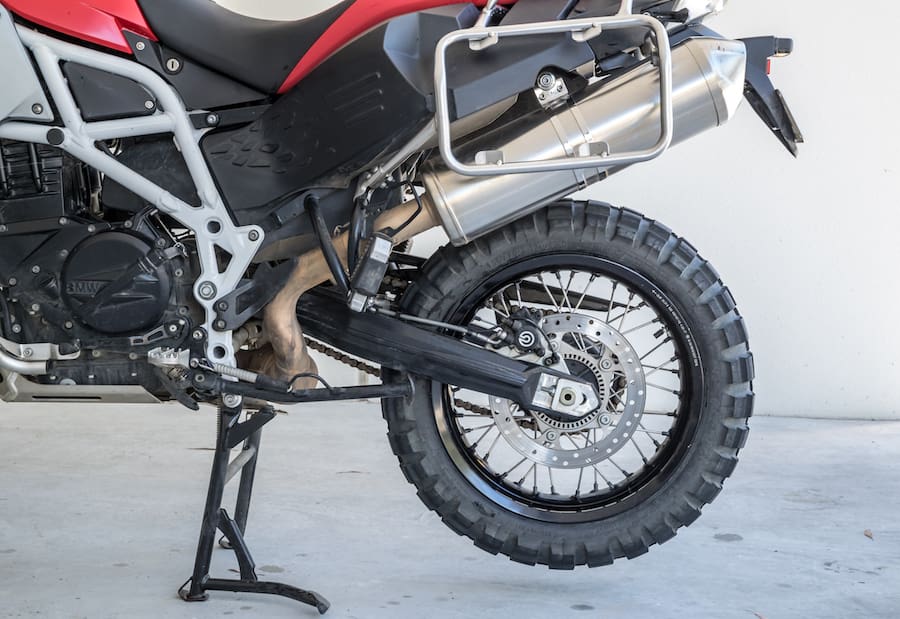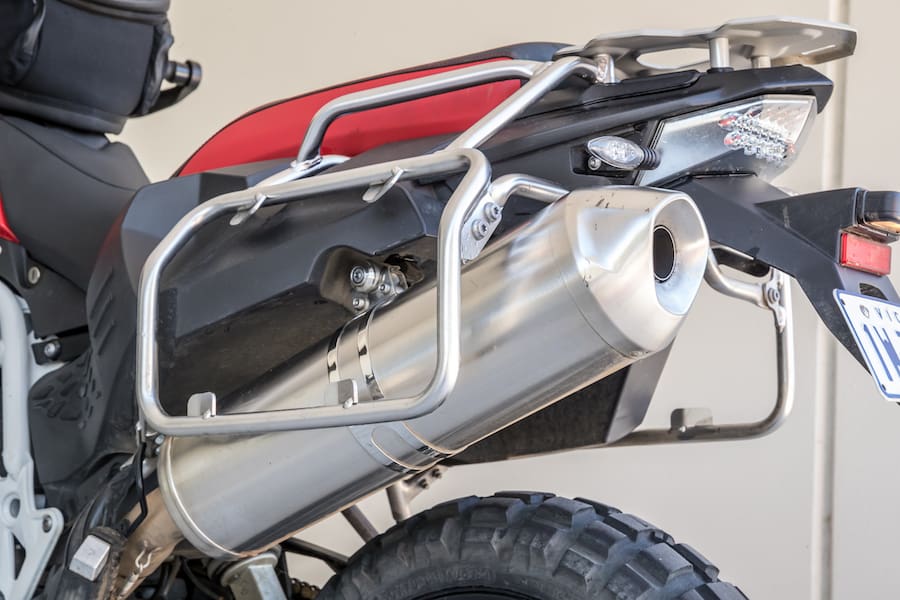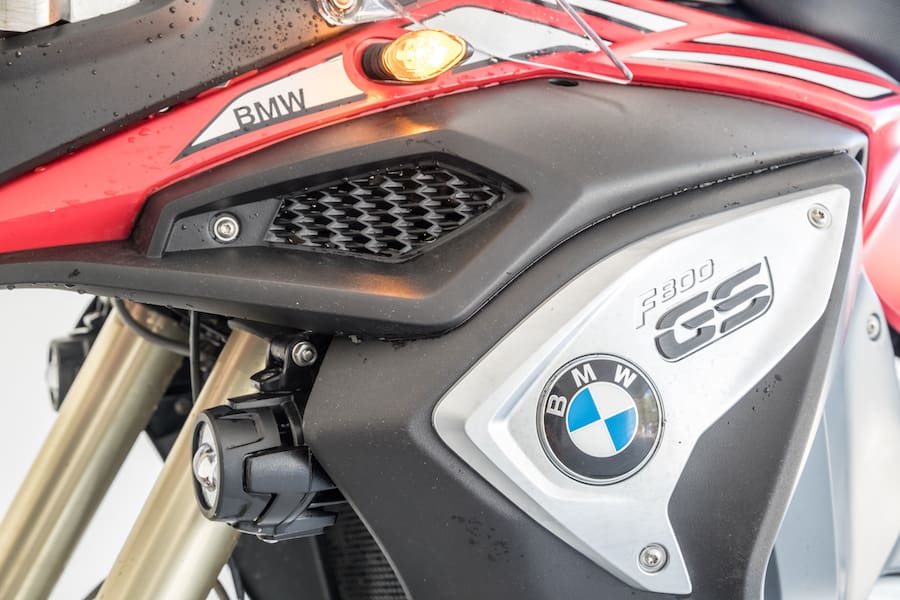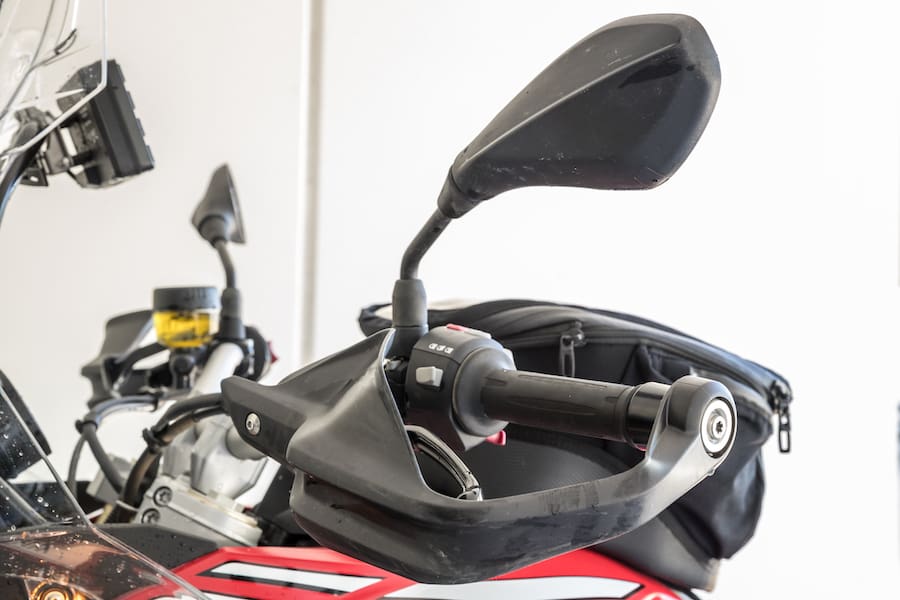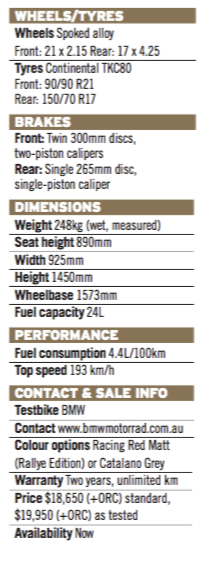Don’t drop it!” was bouncing off the walls of my skull as I wrestled to keep the BMW F800 GS Adventure from flipping the ramp and sending us both sprawling off the edge of the bike transporter. After a few tentative moments I managed to coax it up the lopsided ramp and into the van so I could compose myself. Crap. I might need a hand to unload this one. How embarrassing. It was the closest I’d come to dropping a bike without actually riding it, and the realisation came as a big slice of humble pie. As I stood in our van ruminating on my inadequacies, the 240kg bulk of F800GS Adventure rapidly sapped the remaining strength from my arms.
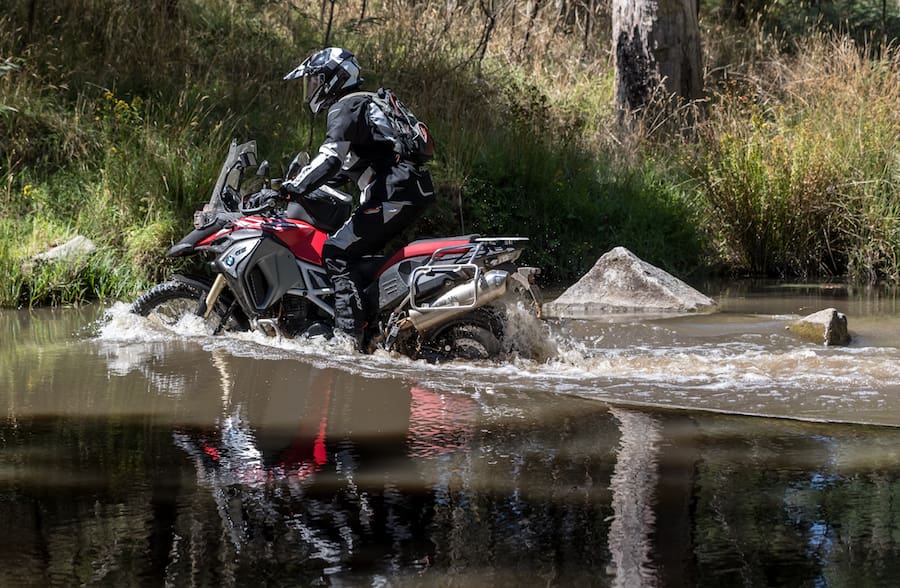
The F800GS Adventure is the smaller-capacity sibling of the R1200GS Adventure, but its status as a mid-range model didn’t buoy my confidence one bit. How the hell was I going to ride this thing off road if I couldn’t even unload it? The most pressing question on my mind now was whether it was even possible for an Average Joe to successfully make the jump from roadbikes to long-legged adventurers. I could already picture the lads at Gassit HQ having a good chuckle as they joked about me having the time of my life while I courted disaster off road.
It was a pretty big step up from my last ‘adventure bike’, the petite and flickable Yamaha WR250R, which is a far cry from the kind of luggage-hauling packhorses that Ewan McGregor and Charley Boorman used to traverse continents. But in saying that, the challenge was probably no more daunting than the prospect faced by riders who take the plunge every year and fork out their hard earned on a new or second hand-bike from BMW’s Adventure Touring range. And there are plenty of them. Now, more than ever, motorcyclists are getting on the adventure bike bandwagon because of the incredible versatility, durable construction and reliable engineering of these machines. It was time to see what all the fuss is about.
“It’ll do over 500km to a tank” explained Miles Davis, the Marketing Manager for BMW Motorrad, when he handed me the keys. The Adventure version of the F800GS model cops a 24-litre fuel tank, engine protection bars, bash plate, enduro footpegs with removable rubber inserts, hand-protection guards, extra large screen, pannier racks, and knobby Continental TKC80 hoops. That’s some seriously purposeful fruit for off-road riding and longer tours.
It’s a new generation of BMW’s mid-range model, but not so different from the one that Miles’ mates used in their attempt to conquer the Simpson Desert’s French line a few years back. Changes for 2017 include new paint schemes such as the optional Rallye Red shown here and galvanised radiator trim, a new dashboard, revised ignition lock casing, and full ride-by-wire throttle with different modes and a new exhaust to meet Euro 4 emissions standards. The core pieces of the puzzle, like the chassis, engine and strengthened tubular steel rear subframe remain the same, so we know deep down that this bike is capable of dealing with just about anything Australia can throw at it.

I know what the F800GS can do in capable hands, but what about in the ham-fisted grabbers of folk like me? I certainly felt suitably inept as I finally wrestled it out of the van, and was quietly confident that I satisfied the Average Joe criteria. After the unloading fiasco I started packing for the two-day overnight adventure, and tried (unsuccessfully) to put the possibility of getting pinned beneath its massive bulk in the middle nowhere as far from my mind as possible…
When you come face to face with the F800GS Adventure you quickly realise that it’s a serious bit of kit with some intimidating dimensions. A little limbering up is advisable to get a leg over the 890mm high seat for those unaccustomed to riding motorcycles with long range suspension travel, and even at 6ft tall I found it to be a stretch. BMW does have an 860mm low seat option, but once the clumsy process of mounting is behind you, it’s a pleasure to settle in and enjoy the spacious, upright riding position as you pass the world by.
My first ride on the F800GS coincided with an intense thunderstorm that rolled in unannounced, but there’s always a silver lining as it was the ideal opportunity to test the gentler throttle response of the Rain mode. The ride-by-wire throttle technology on this year’s model allows changes between the two standard modes (Rain and Road) with the flick of a button on the right switchblock and just a momentary closing of the throttle. Rain mode takes the edge off initial throttle response, and dials up the ABS and traction control (BMW calls it Automatic Stability Control or ASC) as a nice physical and psychological safety net. However, even in the flooded urban environment I found the electronic aids were a little too intrusive so I returned to ‘Road’ settings. This still felt very progressive and predictable, even with the brand new knobby tyres fitted. The twin auxiliary lights positioned either side of the radiator also came in handy, illuminating the shining road surface as I tried to avoid the painted lines in the thick spray of passing vehicles. Even in the dastardly conditions there was zero sign that a lock-up under engine braking caused by downshifting was possible. The mechanically operated clutch is extremely precise, with a very light action that makes it effortless to snick through the six-speed box.
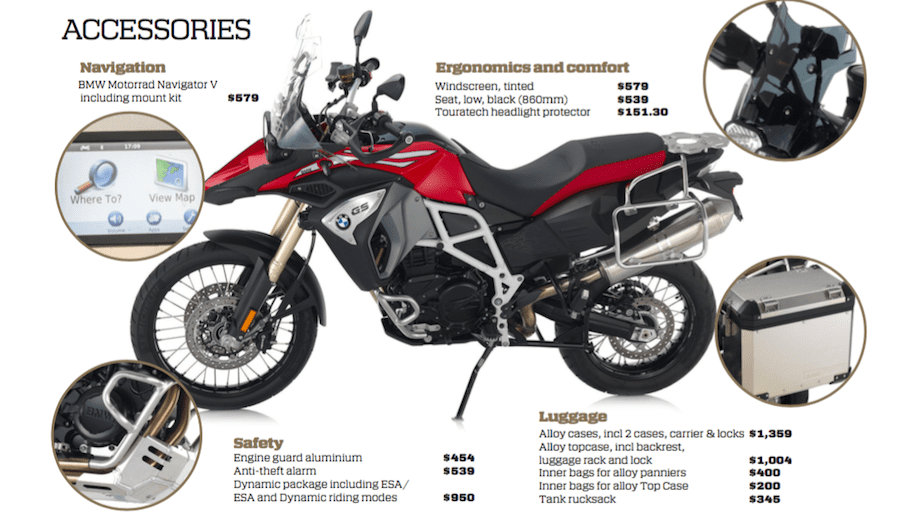
The next morning I awoke to clear skies with the reassurance that my off-road route across Victoria’s Central Highlands had been nicely softened up. On the initial escape from Melbourne’s CBD I was struck by just how linear and tractable the super smooth 798cc parallel-twin engine is in the dry. There’s no snatchy fuelling or nasty vibes, just clean, crisp acceleration driving the rear wheel into the asphalt as it works its way towards the formidable 83Nm peak torque at 5750rpm, and peak power of 63kW at 7500rpm. The buttery smooth delivery is helped by an additional connecting rod to compensate for first and second order inertia forces – an engineering strategy often used to dampen vibrations in lumpy single-cylinder donks. On the Beemer this smoothness helps to generate instant confidence in slick conditions, and is one of those traits that encourage the rider to go off road regardless of their prior experience.
The model on test had the ‘Dynamic’ ECU package with both the ‘Enduro’ and the ‘Enduro Pro’ mode, which is designed to improve throttle response and Automatic Stability Control and ABS intervention settings for off-road riding. There’s also Electronic Suspension Adjustment (ESA) included in the Dynamic package, which allows you to adjust the preload on the rear shock remotely via the left switchblock. Three different modes that use intuitive names for gradually higher amounts of spring preload are available (Comfort, Road and Sport), and while there’s no ESA or adjustability up front, the fork uses a base setting for preload, rebound and compression damping that offers superb feedback both on and off road.
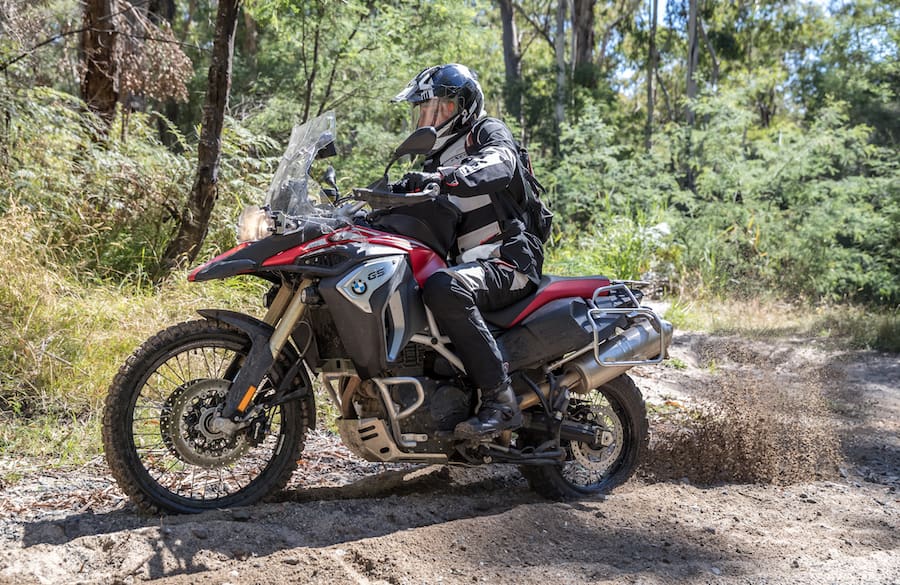
On my first forays into the long rolling hills of slate grey shale that flank Victoria’s central highlands I wasn’t taking any chances and switched immediately into the Enduro mode. This softened up the power delivery from ‘Road’ mode, and I was rewarded with confidence-inspiring control through the wide ’bar and stable chassis. The bike’s planted cornering nature was still there, despite the loose surface, but this highly tuned electromotive control made it possible to get on the juice hard out of corners with full confidence. Aggressive throttle inputs incited a bit of predictable wheel slip that was offset by the TC, but it didn’t take long before that was dialled down courtesy of a quick switch to the more purposeful Enduro Pro mode which also disables rear ABS. These two off-road modes are optional extras but they really are worth every penny on the Adventure model which does its best work off the beaten track. Even high-level riders who are accustomed to riding loose will benefit from having these electronic aids, but it’s still possible to turn everything off by pressing and holding the ASC button on the switchblock when you want to really test yourself.
I found overcoming small obstacles a breeze with the 21-inch front a 17-inch rear wire wheel combination, backed up with 230mm spring travel at the front and 215mm at the rear. So naturally I turned up the wick and tried my hand at ‘brake drifts’. As I started to push harder into turns to test the stopping power of the front two-pot Brembos and twin 300mm discs, the front end remained predictable with excellent feel transmitted through the sturdy 43mm fork. By gently weighting the footpeg it was easy to coax the tall F800GS Adventure into its arc with a smooth drift. The precise fuelling of each mode made it possible to deliver a healthy hit of beans mid-corner, along with a little body english, to point and shoot the bike towards the exit. I never expected it would, or could, be this easy. For such a large and heavy motorcycle to feel so predictable and planted on loose terrain was mind boggling, but somehow it just felt right, and the consequence was that I felt more in control than the sum of my experience could justify.
Of course, like any machine, there are a few small areas where improvements could be made. From a mechanical point of view, the engineering is as precise as anything I’ve ridden from the Bavarian manufacturer, but the layout of the dash is cluttered despite being overhauled on this year’s model. The newly designed set of analogue dials sits alongside an LCD display, but a large screen to display the speedometer would have made it easier to check the travelling speed given how far you’re positioned away from the dash while riding. On the subject of screens, the actual wind deflection screen on the F800GS Adventure also seemed to be just at the wrong height for me at highway speeds, sending all the turbulence and buffeting directly into the visor of my peaked adventure lid. This was eliminated if I ducked down behind the screen or stood tall, but nonetheless, having a manually adjustable screen for long stints of open road would have been a welcome addition. Cruise control is another feature which would have been put to good use on this model given the distances it can conquer on a single tank, but no factory option is available.
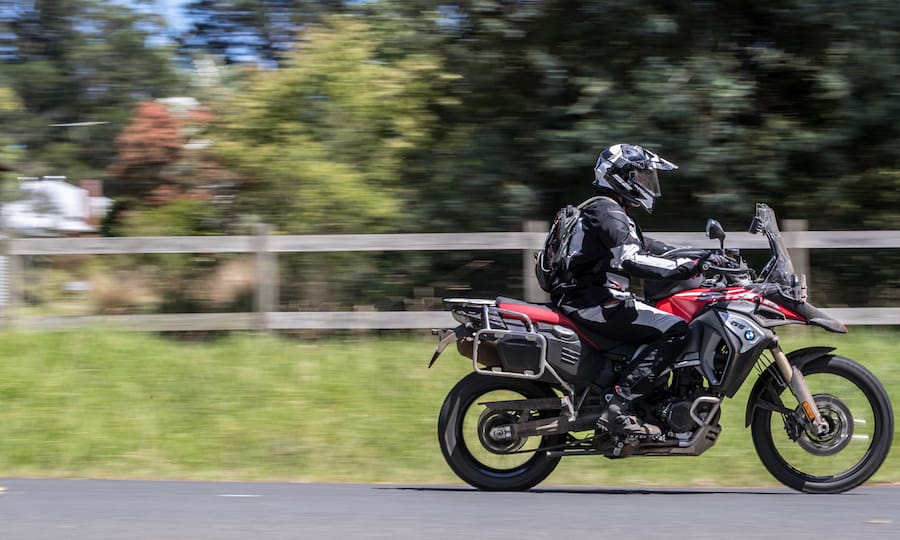
After a small taste of mid-size multi-day adventure riding I can really understand the popularity of this pastime. On the road, you can ride for hours loaded to the hilt with gear, and get wherever you need to be fast while still enjoying the trip irrespective of the tarmac quality under your tyres. On the dirt, you’ve just opened up a whole new method of transit that gives its kicks at 40 clicks with endless possibilities to explore. Having the capability to go off road and get off the beaten track away from traffic and road tax enforcers, to embrace Australia’s beautiful natural environment, is an experience that few other pastimes can offer.
And this BMW really does straddle the gap between the two contrasting disciplines of road and off-road riding to offer the best of both worlds. In fact, probably the most trouble you’re likely to get into on the F800GS Adventure is if you decide to load it into a transporter on your own.

TEST Paul McCann
PHOTOGRAPHY Mark Dadswell
